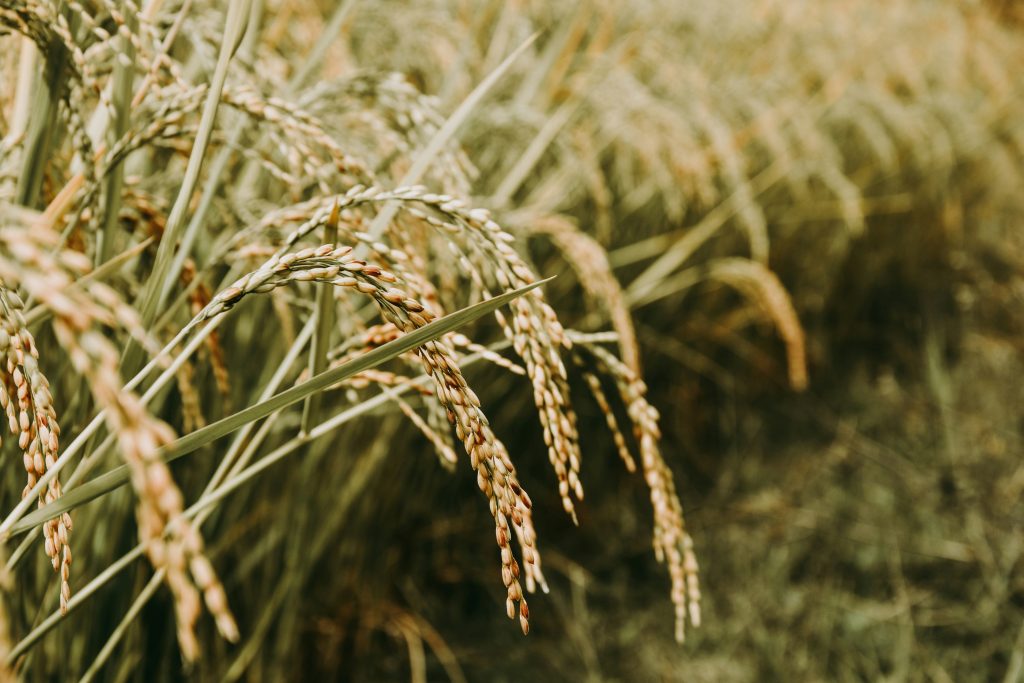Cereal crops, also known as grains, refer to grass species cultivated for their edible seeds or grains, which serve as vital sources of food, feed, and industrial materials worldwide. Examples of cereal crops include wheat, rice, maize (corn), barley, oats, rye, sorghum, millet, quinoa and more.
These crops play a foundational role in global agriculture, contributing significantly to human nutrition, livestock feed, and various industrial applications. They form the basis of staple foods consumed by billions of people, showcasing their critical importance in sustaining livelihoods and supporting agricultural economies globally.
Examples of cereal crops
- Wheat (Triticum spp.)
- Rice (Oryza sativa)
- Maize (Corn) (Zea mays)
- Barley (Hordeum vulgare)
- Oats (Avena sativa)
- Rye (Secale cereale)
- Sorghum (Sorghum bicolor)
- Millet (Pennisetum glaucum)
- Quinoa (Chenopodium quinoa)
- Teff (Eragrostis tef)
- Spelt (Triticum spelta)
- Emmer (Triticum dicoccum)
Wheat (Triticum spp.)
One of the most widely cultivated cereal crops globally, wheat is used for flour production in baking bread, pastries, and other baked goods. It comprises diverse varieties including durum wheat, used for pasta, and soft wheat, for cakes and pastries.
Rice (Oryza sativa)
Serving as a staple food for over half of the world’s population, rice comes in various types such as long-grain, medium-grain, and short-grain, each with unique culinary properties. It is integral to many Asian, African, and Latin American cuisines.
Maize (Corn) (Zea mays)
A versatile crop used for food, feed, and industrial purposes, maize is utilized in the production of cornmeal, corn syrup, ethanol, and animal feed. It plays a significant role in the diets of many cultures worldwide.
Barley (Hordeum vulgare)
Primarily used for brewing beer and whiskey, barley is also utilized as animal feed and in soups, stews, and salads. It is known for its tolerance to diverse environmental conditions.
Oats (Avena sativa)
High in dietary fiber and known for their heart-healthy properties, oats are commonly consumed as oatmeal or rolled oats for breakfast. They are also used in baking and as livestock feed.
Rye (Secale cereale)
Thriving in colder climates and poor soils, rye is used for making rye bread, whiskey, and as a cover crop to prevent soil erosion. It contains more fiber and nutrients compared to wheat.
Sorghum (Sorghum bicolor)
An important cereal crop in arid and semi-arid regions, sorghum is used for food, fodder, and ethanol production. It is a gluten-free grain gaining popularity in various food products.
Millet (Pennisetum glaucum)
A drought-tolerant cereal crop grown in dry regions, millet is consumed as a staple food in many parts of Africa and Asia. It is also used as birdseed and in traditional alcoholic beverages.
Quinoa (Chenopodium quinoa)
A pseudocereal known for its high protein content and nutritional value, quinoa is a gluten-free grain alternative gaining popularity in health-conscious diets. It is native to the Andean region of South America.
Teff (Eragrostis tef)
An ancient grain native to Ethiopia and Eritrea, teff is used to make injera, a traditional Ethiopian flatbread. It is rich in essential nutrients like iron and calcium.
Spelt (Triticum spelta)
An ancient grain with a nutty flavor and high nutritional value, spelt is tolerant to poor soils and adverse weather conditions. It is used in baking, cooking, and as livestock feed.
Emmer (Triticum dicoccum)
An ancient wheat variety with a high protein content, emmer was historically cultivated in the Fertile Crescent region. It is used in baking, brewing, and as a cover crop.

Uses of cereal crops
- Food Production: Cereal crops are primary sources of carbohydrates, proteins, and essential nutrients in the human diet.
- Livestock Feed: Cereal grains are integral components of animal feed formulations, providing energy and nutrients for livestock.
- Industrial Applications: Cereal crops are utilized in various industrial processes, including biofuel production, starch extraction, and brewing.
- Food Additives: Cereal-derived additives such as starches and syrups are widely used in food processing and manufacturing.
- Cereal Beverages: Grains like barley are used in the production of beverages such as beer and whiskey.
- Breakfast Cereals: Processed cereal products like breakfast cereals are popular morning meal options in many parts of the world.
- Flour Production: Cereal grains serve as the primary raw material for flour production, which is used in baking and cooking.
- Snack Foods: Cereal grains are integral ingredients in various snack foods, including granola bars and popcorn.
- Dietary Supplements: Cereal-based supplements provide additional nutrients and dietary fiber for individuals with specific nutritional needs.
- Culinary Uses: Cereal crops are used in diverse culinary applications, from traditional dishes to innovative recipes.
Read also: Classification of crops
Characteristics of cereal crops
Cereal crops share several common characteristics that contribute to their widespread cultivation and utilization:
- Grain Production: Cereal crops are primarily cultivated for their grains, which are rich in carbohydrates and serve as valuable sources of energy.
- Adaptability: Many cereal crops exhibit a remarkable ability to adapt to diverse environmental conditions, including variations in climate, soil types, and altitude.
- High Yield Potential: Cereal crops often possess high yield potential, making them efficient sources of food and feed for human and animal consumption.
- Cultural Significance: Cereal crops hold cultural significance in many societies, often featuring prominently in traditional rituals, ceremonies, and culinary traditions.
- Genetic Diversity: Cereal crops exhibit significant genetic diversity, which enables breeders to develop improved varieties with enhanced traits such as disease resistance, drought tolerance, and yield potential.
- Staple Food Status: In numerous regions worldwide, cereal crops serve as staple foods that form the basis of daily diets and contribute significantly to nutritional intake.
The bottom line
Cereal crops represent a cornerstone of global agriculture, providing sustenance, livelihoods, and economic opportunities to millions of people worldwide. With their diverse uses, adaptability, and nutritional value, cereal crops play a vital role in addressing food security challenges and supporting sustainable development efforts across the globe. Understanding the significance and characteristics of cereal crops is essential for promoting agricultural innovation, improving food systems, and ensuring the well-being of present and future generations
